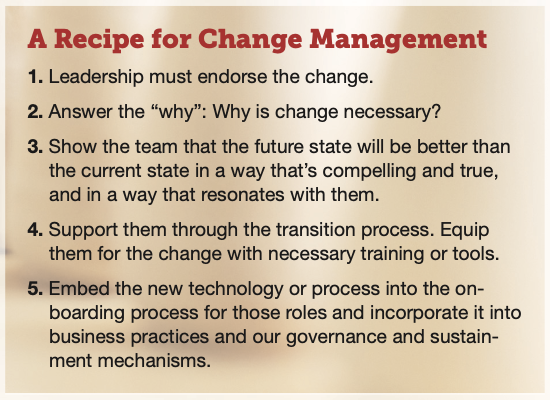Change is inevitable in life and in business, but Julie Heinz at ExxonMobil says it doesn’t have to be a confusing or painful process. As ExxonMobil’s corporate change management office manager, Heinz guides employees through the rigors of change by providing understanding and support in a manner that will give it “stickability.”
Her Baton Rouge office, created in 2021, seeks to deliver optimal value during the implementation of any new initiative, solution or project by enabling employees to more seamlessly adopt those changes. Heinz has four direct reports, but also facilitates a global community of change leaders. In turn, a “hub-and-spoke” model, comprised of various change teams across ExxonMobil’s portfolio, works specific initiatives within individual parts of the organization.
Heinz is passionate about establishing enterprise-wide change management practices and is a certified Prosci change management practitioner and trainer. “A lot of my people don’t necessarily have a change management background,” Heinz says. “I look for people who are eager to learn and adapt quickly. Strong communication skills are important. Analytical skills are also a must.
“When it comes to implementing change, we’re not the domain experts. In our role, we help people think through how they adapt to change, coordinate activities to integrate the change, and guide them through exercises and assessments to determine the impact of the change.”

10/12 Industry Report sat down with Julie Heinz to discuss the purpose of change management and what she’s discovered since taking over her role in 2021.

How would you define “change management”?
Change management is a strategic approach to preparing, equipping and supporting people for change. In the world, the rate of change is exponential. It’s never stopping and never slowing down. We need to be able to adapt and quickly capture the value of what we’re trying to do so we can move in the direction we need to move as a competitive organization.
Is it a new concept for the industrial sector?
Based upon my own observations, ExxonMobil is a bit of a leader in this space. As a corporation, we’ve gone through a maturity journey. We’ve found that change management is a competency that we all need as employees. We need to have the resilience and capacity to change in an effective manner.
Historically, change management was given a lower priority. But we now realize that if we don’t have the right solution with the right process and strategy behind it and aren’t supporting our people to understand its value and the case for change, we won’t get the value. That value proposition is what makes change management critical. We want to have a work force that has clarity and is energized with the direction we’re going.
What are the steps in the change management
process?
Step one is endorsement by leadership. Having a leader endorse the new strategy and convey to the employees that we’re going to guide them through the process and support them … that’s a big part of it. You must also answer the “why.” If you can’t show them that the future state will be better than the current state in a way that’s compelling and true, and in a way that resonates with them, they’re not going to come aboard. Therefore, it’s incumbent upon us to convey that we’re rolling things out that will make their lives more productive and better as employees, or it will generate some value to the corporation.
Next, we must support them through the transition process, provide them with any necessary training or tools that they’ll need, and equip them for the change.
The sustainment piece is equally critical. You can’t just roll something out and expect it to stick forever. People often change jobs, so we need to make sure the new technology or process is imbedded into the onboarding process for those roles. It should also be incorporated into our business practices and our governance and sustainment mechanisms. When we put all these pieces together, we create the right recipe for getting folks to really adopt the change.
Any recent examples of how change management processes are working for ExxonMobil?
ExxonMobil recently announced some significant organizational changes that will create a Global Business Solutions organization and a Centralized Supply Chain organization. These will have a huge organizational impact, but will require a shift in mindset to be effective. Through our change management processes we’re making sure that our people understand how we need to think differently and use these different processes. We want to ensure that they understand how the future state is better than the current state.
How do you measure the success of what you’re doing?
Measurement is definitely a part of it. Sometimes it’s qualitative, but at times it’s quantitative. For example, after implementing a new mobile application for instrument calibrations in the field, we were able to monitor usage of that system to gauge our success.
However, when you’re implementing something that’s a process or mindset change, it can be a bit tougher. We use the ADKAR (Awareness, Desire, Knowledge, Ability and Reinforcement) model, a well-known industry standard for change management. We strive to help our employees understand the case for action (Awareness), gauge their willingness to adopt the change (Desire), equip them with the information or tools they need (Knowledge), guide them through the process of adopting the change (Ability) and provide support upon implementation (Reinforcement).
If we are implementing change at a particular site, one of the first things we’ll do is meet with key stakeholders to build awareness and desire. I’ll tell them what we’re doing, why we’re doing it and why it’s valuable in order to get their support. We’ll follow up with some simple questions across various people groups and across time to gauge whether we’ve been effective in adopting the change.
What happens when the feedback is negative?
I always say, “Don’t ask for feedback if you’re not going to do anything with it.” Can we address every piece of feedback? No, but at least we can tell them why and help them understand the context a little better. Or perhaps the resistance is for a very good reason. Maybe there are multiple changes planned during the same quarter and they’re overwhelmed.
I think it’s a condescending comment to say people hate change. I think that they don’t like unnecessary change or poorly planned change, but if something is a good solution, solves problems for them, is easy to use, and they have the right support, they’ll come along. We need to make sure that the change solves a real problem. That makes change management so much easier for us.









